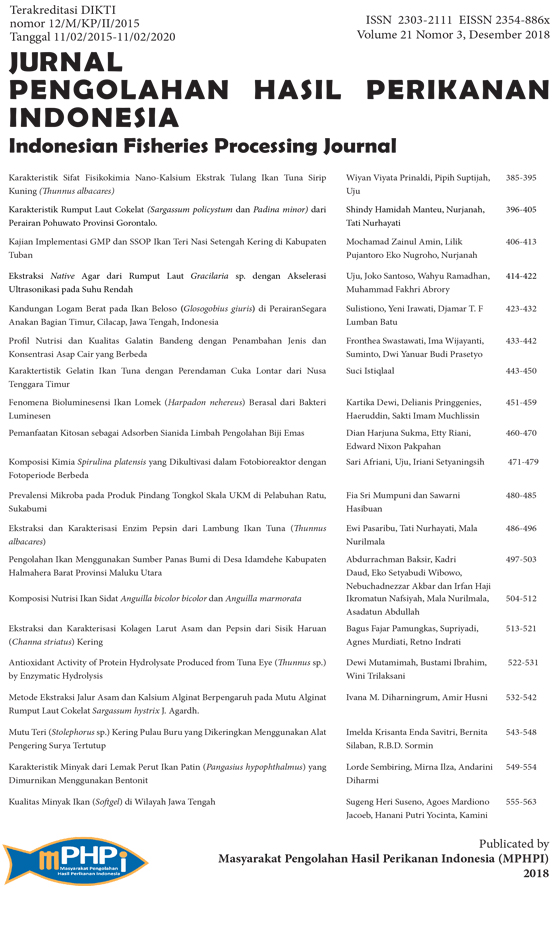ANTIOXIDANT ACTIVITY OF PROTEIN HYDROLYSATE PRODUCED FROM TUNA EYE (Thunnus sp.) BY ENZYMATIC HYDROLYSIS
Abstract
Tuna (Thunnus sp.) by-products from frozen loin and canning industry especially the eye is rich in proteins and in lipids consisting of polyunsaturated fatty acids (PUFA). That requires protective agent (antioxidant) to inhibit the oxidation naturally present and predicted to be protein peptides. Enzymatic hydrolysis of protein is an appropriate method to produce bioactive peptide with such nutraceutical/pharmaceutical function such as an antioxidant peptide. This study aimed to produce protein hydrolysate having a function as anwith an antioxidant activity from eye of tuna through enzymatic hydrolysis and determining the antioxidant activity by DPPH methods. Protein soluble content of tuna’s eye protein hydrolysate (TEPH) ranged from 59.98±0.130 to 94.90±0.002%. The degree of hydrolysis (DH) of TEPH was about 9.10±0.28 to 16.14±0.09%. The highest inhibition of DPPH radical scavenging activity was 93.57±0.05% (at 5 mg/mL) was obtained with a DH of 11.35±0.002% at the concentration 0.1% of papain for 6 hours hydrolysis. The IC50 value of was 1.08±0.008 mg/mL
Authors
MutamimahD., IbrahimB., & TrilaksaniW. (2018). ANTIOXIDANT ACTIVITY OF PROTEIN HYDROLYSATE PRODUCED FROM TUNA EYE (Thunnus sp.) BY ENZYMATIC HYDROLYSIS. Jurnal Pengolahan Hasil Perikanan Indonesia, 21(3), 522-531. https://doi.org/10.17844/jphpi.v21i3.24736
Authors who publish with this journal agree to the following terms:
- Authors retain copyright and grant the journal right of first publication with the work simultaneously licensed under a Creative Commons Attribution License that allows others to share the work with an acknowledgement of the work's authorship and initial publication in this journal.
- Authors are able to enter into separate, additional contractual arrangements for the non-exclusive distribution of the journal's published version of the work (e.g., post it to an institutional repository or publish it in a book), with an acknowledgement of its initial publication in this journal.





